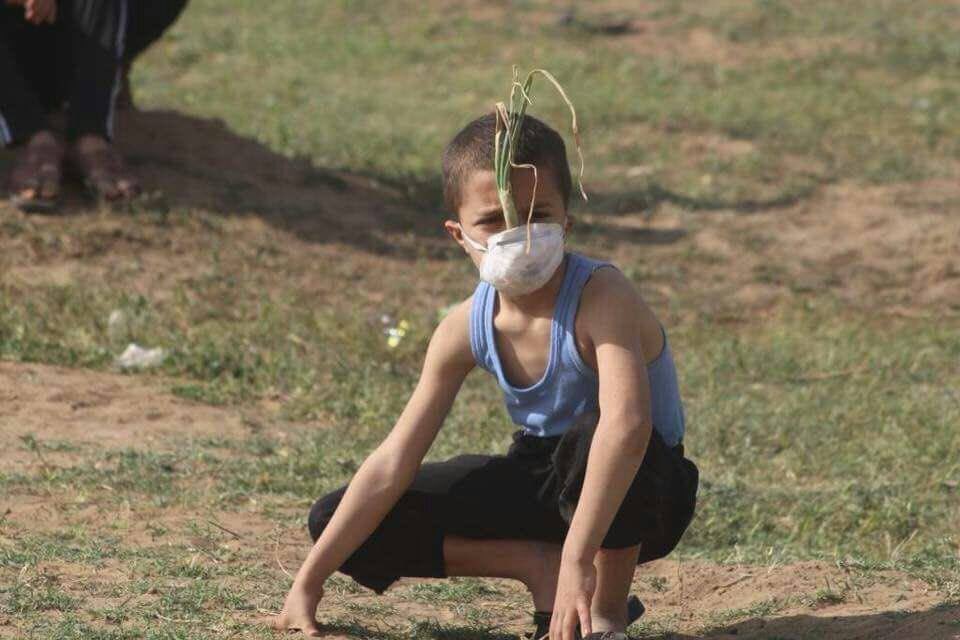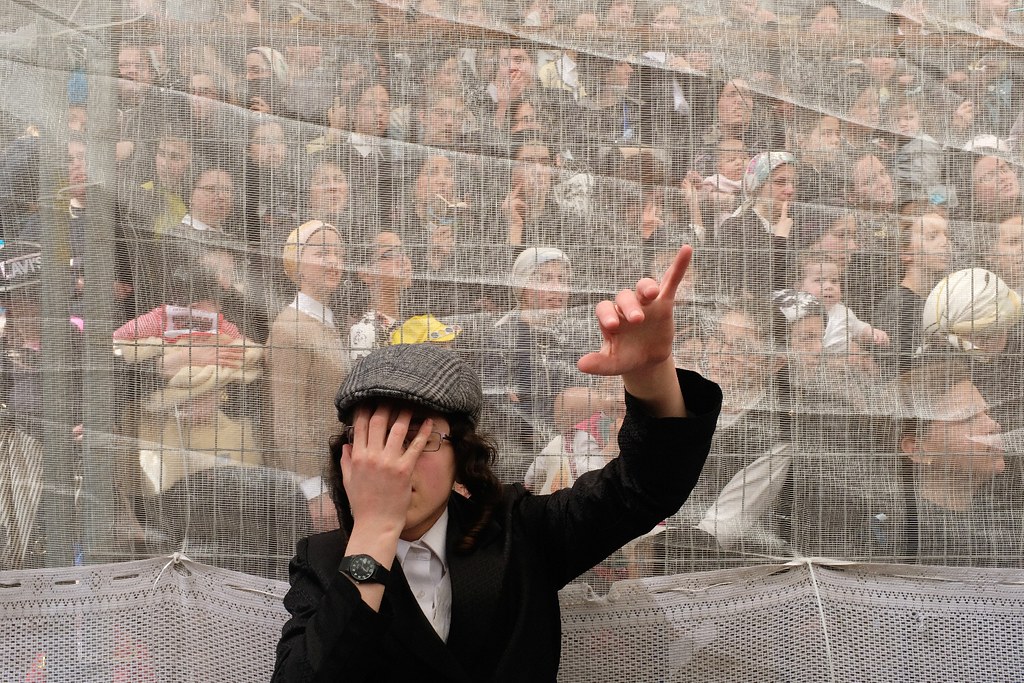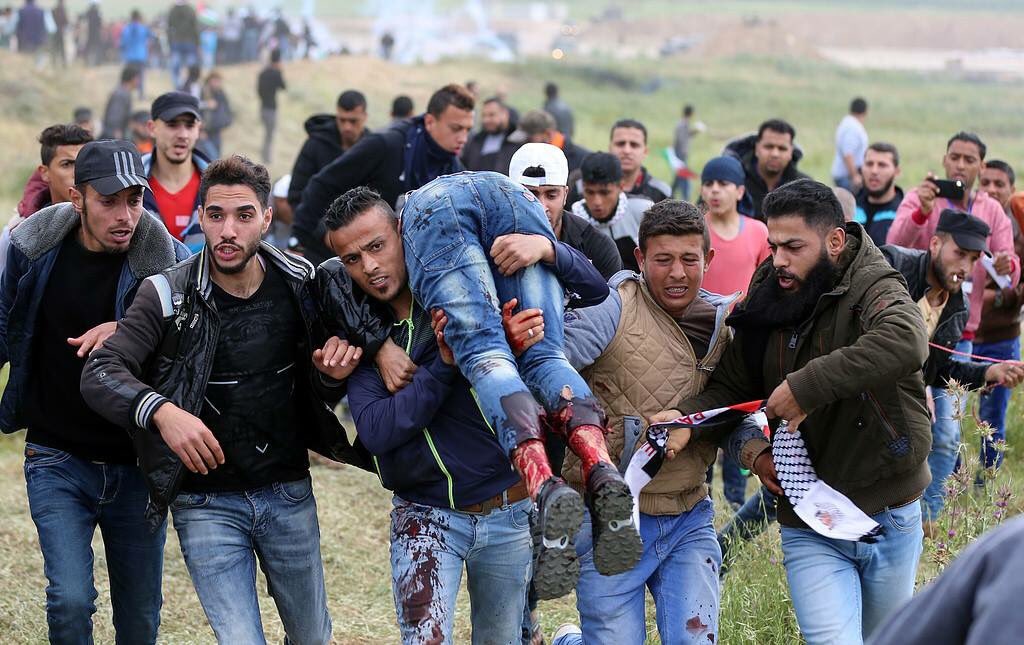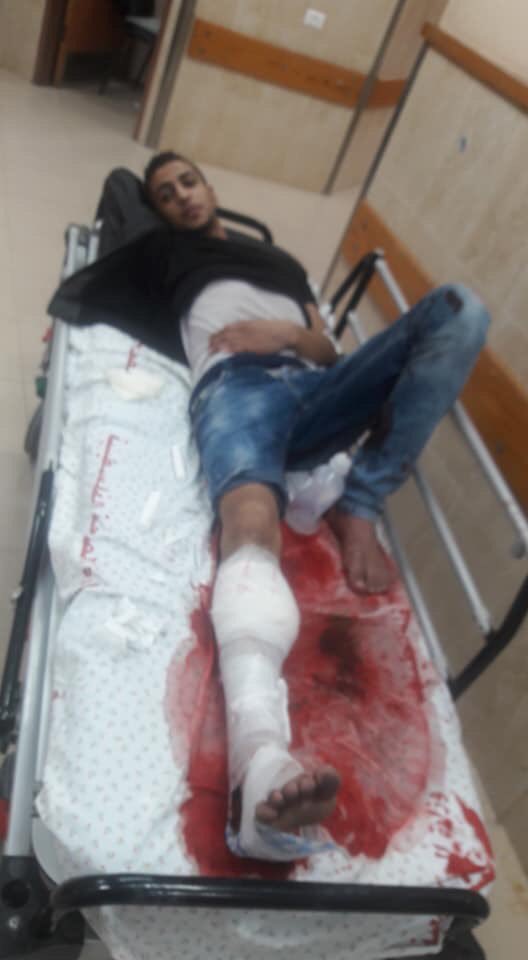
Palestinian
kid using a simple mask and putting onions inside it to protect himself
from the gas bombs thrown by Israeli occupation forces on the
protesters at #Gaza borders. #GreatReturnMarch: image via Yousef @Joo_Gaza, 1:29 AM 31 March 2018

More than 1,000 demonstrators were wounded by Israeli snipers during the protest: photo by Hosam Salem/Al Jazeera, 30 March 2018 ![The march was called for by civil society organisations who stressed that it should be a peaceful protest. [Hosam Salem/Al Jazeera]](https://www.aljazeera.com/mritems/Images/2018/3/30/b9e6707068b24b15aa8889b9ebe3bba1_8.jpg)
The march was called for by civil society organisations who stressed that it should be a peaceful protest.: photo by Hosam Salem/Al Jazeera, 30 March 2018
Some 80 percent of the Gaza Strip's population are dependent on humanitarian assistance, owing to a decade-long Israeli blockade.: photo by Hosam Salem/Al Jazeera, 30 March 2018
Palestinians have set up tents along the border with Israel and will carry out a six-week sit-in demonstration leading up to the commemoration of the 1948 Nakba.: photo by Hosam Salem/Al Jazeera, 30 March 2018
Many
of the 1.3 million Palestinians who live in refugee camps throughout
the Gaza Strip hail from villages and towns just across the border with
Israel.: photo by Hosam Salem/Al Jazeera, 30 March 2018 ![Protesters in Gaza gathered in five different spots along the border, originally positioned about 700 metres away from the fence. [Hosam Salem/Al Jazeera]](https://www.aljazeera.com/mritems/Images/2018/3/30/642ca3da16a04b30867e7188b8afec8e_8.jpg)
Protesters
in Gaza gathered in five different spots along the border, originally
positioned about 700 metres away from the fence.: photo by Hosam Salem/Al Jazeera, 30 March 2018 ![A makeshift field clinic to treat those wounded during the protest. [Hosam Salem/Al Jazeera]](https://www.aljazeera.com/mritems/Images/2018/3/30/89e2a7a61d1045369f76cdcd86e6284c_8.jpg)

Untitled [Purim ceremony, Jerusalem]: photo by Fabian Schreyer // shootingcandid, 2 March 2018
Friday
noon prayers took place in the Malka area east of Gaza city with the
presence of Palestinian political leaders, including Hamas' Ismail: photo by
Haniya Hosam Salem/Al Jazeera, 30 March 2018
Gaza: Refugees call for right of return in mass protests: Thousands in Gaza Strip attend mass demonstration calling for the return of Palestinian refugees.: Hosam Salem, Al Jazeera, 30 March 2018
Israeli
forces have killed at least 15 Palestinians and wounded more than 1,000
others during a mass protest near the Gaza Strip's eastern border.
Thousands attended Friday's protest, dubbed the Great March of
Return, which was organised by several Palestinian civil society
organisations and backed by all of political factions.
The protest marked the 42nd anniversary of Land Day
- on March 30, 1976, six unarmed Palestinian citizens of Israel were
killed by Israeli forces during protests against the Israeli
government's decision to expropriate massive tracts of Palestinian land.
Protesters said the main message of the march was to call for the right of return for Palestinian refugees.
Tents were also set up on five different points along the border, a
move kicking off six weeks of a sit-in demonstration leading up to the
70th anniversary of the Nakba on May 15.
A man tries to put out the smoke from a tear gas canister fired by the Israeli army at Palestinian demonstrators.: photo by Hosam Salem/Al Jazeera, 30 March 2018
![The march was called for by civil society organisations who stressed that it should be a peaceful protest. [Hosam Salem/Al Jazeera]](https://www.aljazeera.com/mritems/Images/2018/3/30/b9e6707068b24b15aa8889b9ebe3bba1_8.jpg)
Israeli soldiers and an army observation tower seen in the distance across from the Gaza border with Israel, east of Gaza City.: photo by Hosam Salem/Al Jazeera, 30 March 2018
Some 80 percent of the Gaza Strip's population are dependent on humanitarian assistance, owing to a decade-long Israeli blockade.: photo by Hosam Salem/Al Jazeera, 30 March 2018
Palestinians have set up tents along the border with Israel and will carry out a six-week sit-in demonstration leading up to the commemoration of the 1948 Nakba.: photo by Hosam Salem/Al Jazeera, 30 March 2018
A
family sits in front of their tent east of Gaza City. They have hung up
signs of the names of their original villages to which they hope to
return.: photo by Hosam Salem/Al Jazeera, 30 March 2018
![Protesters in Gaza gathered in five different spots along the border, originally positioned about 700 metres away from the fence. [Hosam Salem/Al Jazeera]](https://www.aljazeera.com/mritems/Images/2018/3/30/642ca3da16a04b30867e7188b8afec8e_8.jpg)
![A makeshift field clinic to treat those wounded during the protest. [Hosam Salem/Al Jazeera]](https://www.aljazeera.com/mritems/Images/2018/3/30/89e2a7a61d1045369f76cdcd86e6284c_8.jpg)
A makeshift field clinic to treat those wounded during the protest.: photo by Hosam Salem/Al Jazeera, 30 March 2018

Last
picture of the Palestinian youth Abd AlFatah before the Israeli
Zionists bastards snipers shot him in the head directly and killed
him in cold blood. #GreatReturnMarch: image via Yousef @Joo_Gaza, 1:29 AM 31 March 2018

Summary of the #GreatReturnMarch in #Gaza strip during the peaceful protests at #Gaza borders Friday Yesterday. The Israeli Zionists did this: 20 young men killed 500 young men legs amputated 1800 injuries by the direct fires from Israeli snipers.: image via Yousef @Joo_Gaza, 12:09 AM 31 March 2018

Summary of the #GreatReturnMarch in #Gaza strip during the peaceful protests at #Gaza borders Friday Yesterday. The Israeli Zionists did this: 20 young men killed 500 young men legs amputated 1800 injuries by the direct fires from Israeli snipers.: image via Yousef @Joo_Gaza, 12:09 AM 31 March 2018

Summary of the #GreatReturnMarch in #Gaza strip during the peaceful protests at #Gaza borders Friday Yesterday.
The Israeli Zionists did this: 20 young men killed
500 young men legs amputated
1800 injuries by the direct fires from Israeli snipers.: image via Yousef @Joo_Gaza, 12:09 AM 31 March 2018

As a witness who took part yesterday in the #GreatReturnMarch at #Gaza borders yesterday, I observed that the Israeli Zionists soldiers were targeting
the
Palestinian young men and women directly and shooting them in the head
killing them in cold blood, we were unarmed and just holding flags: image via Yousef @Joo_Gaza, 11:52 PM 30 March 2018 imageimage via Yousef @Joo_Gaza, 11:52 PM 30 March 2018

As a witness who took part yesterday in the #GreatReturnMarch at #Gaza borders yesterday, I observed that the Israeli Zionists soldiers were targeting
the
Palestinian young men and women directly and shooting them in the head
killing them in cold blood, we were unarmed and just holding flags: image via Yousef @Joo_Gaza, 11:52 PM 30 March 2018 imageimage via Yousef @Joo_Gaza, 11:52 PM 30 March 2018

As a witness who took part yesterday in the #GreatReturnMarch at #Gaza borders yesterday, I observed that the Israeli Zionists soldiers were targeting the Palestinian young men and women directly and shooting them in the head killing them in cold blood, we were unarmed and just holding flags: image via Yousef @Joo_Gaza, 11:52 PM 30 March 2018 imageimage via Yousef @Joo_Gaza, 11:52 PM 30 March 2018

As a witness who took part yesterday in the #GreatReturnMarch at #Gaza borders yesterday, I observed that the Israeli Zionists soldiers were targeting
the
Palestinian young men and women directly and shooting them in the head
killing them in cold blood, we were unarmed and just holding flags: image via Yousef @Joo_Gaza, 11:52 PM 30 March 2018 imageimage via Yousef @Joo_Gaza, 11:52 PM 30 March 2018

Summary of the #GreatReturnMarch in #Gaza strip during the peaceful protests at #Gaza borders Friday Yesterday. The Israeli Zionists did this: 20 young men killed 500 young men legs amputated 1800 injuries by the direct fires from Israeli snipers.: image via Yousef @Joo_Gaza, 12:09 AM 31 March 2018

Horrifying that Israel has launched a deadly attack on peaceful protest in Gaza #GreatReturnMarch: image via CODEPINK @codepink, 10:20 AM 30 March 2018

An Israeli sniper today, they killed 14 Palestinians protesters at #Gaza borders, they are evil inhuman Zionists bastards. Go to hell.
Free Palestine #GreatReturnMarch: image via Yousef @Joo_Gaza, 11:34 AM 30 March 2018

Israel has predictably begun killing unarmed demonstrators in the Great March of Return #GreatReturnMarch #FreePalestine: image via Mohammed Khan @sarah_nowha1234, 30 March 2018

Israel has predictably begun killing unarmed demonstrators in the Great March of Return #GreatReturnMarch #FreePalestine: image via Mohammed Khan @sarah_nowha1234, 30 March 2018

Israel has predictably begun killing unarmed demonstrators in the Great March of Return #GreatReturnMarch #FreePalestine: image via Mohammed Khan @sarah_nowha1234, 30 March 2018


I’m shocked the Israeli Zionists snipers were killing and murdering in cold blood the Palestinian youth at #Gaza borders today during the #GreatReturnMarch: image viia Yousef @Joo_Gaza, 30 March 2018

@ShehabAgencyEn: Injuries inflicted by Israeli occupation forces on the 'peaceful' #GreatReturnMarch along the eastern border fence of the #Gaza Strip: image via Shehab News @ShehabAgencyEn, 30 March 2018

@ShehabAgencyEn: Injuries inflicted by Israeli occupation forces on the 'peaceful'

@ShehabAgencyEn: Injuries inflicted by Israeli occupation forces on the 'peaceful'

Israeli soldiers shot across the border with Gaza on Friday as Palestinians gathered for
demonstrations expected to last six weeks.: photo by
Credit
Jack Guez/Agence France-Presse, 30 March 2018

Israeli soldiers shot across the border with Gaza on Friday as Palestinians gathered for
demonstrations expected to last six weeks.: photo by
Credit
Jack Guez/Agence France-Presse, 30 March 2018
Israeli
Military Kills 15 Palestinians in Confrontations on Gaza Border: Isabel
Kershner in Jerusalem and Abuheweila in Gaza, The New York Times, 30
March 2018
JERUSALEM
— Tens of thousands of Palestinians gathered along Gaza’s border with
Israel on Friday to vent their pent-up frustration in a protest that
quickly turned violent, with Israeli forces killing 15 at the border
fence.
As
many as 30,000 arrived early in the day at tent encampments on Gaza’s
side of the fence to stage what was billed as the start of a peaceful,
six-week sit-in. They were protesting against Israel’s longstanding
blockade of the territory and in support of their claims to return to
homes in what is now Israel.
But
as some began hurling stones, tossing Molotov cocktails and rolling
burning tires at the fence, the Israelis responded with tear gas and
gunfire. The Israelis said they also exchanged fire with two gunmen
across the fence and fired at two others who tried to infiltrate into
Israel.
Mohammad
Obaid, an 18-year-old protester, said that holding a Palestinian flag
in one hand and a rock in the other would be enough to get him killed by
an Israeli soldier.
“We
can bring back our lands with the power of guns and weapons, not with a
march, a stone or a knife,” he said after the violence erupted.
Friday’s
flare-up, ignited by isolation and economic deprivation, was the worst
in years in the small Mediterranean enclave. In recent years,
neighboring Egypt has joined Israel in the blockade, and the Palestinian
Authority, which administers the West Bank, has imposed sanctions. With
the territory’s economy collapsing, fears of an explosive backlash have
mounted.
In
December, some Palestinian leaders had called for mass protests when
the United States declared Jerusalem the capital of Israel and said it
planned to move the American Embassy there. Such demonstrations never
materialized.

Protesters carrying a wounded man near the Gaza Strip border with Israel on Friday.: photo Khalil Hamra/Associated Press, 30 March 2018

Protesters carrying a wounded man near the Gaza Strip border with Israel on Friday.: photo Khalil Hamra/Associated Press, 30 March 2018
Instead,
it was a call to protest over the most sensitive issue in the
Israeli-Palestinian conflict — the land itself — that brought
Palestinians out in huge numbers on Friday. And the question, as always,
was whether confrontations would spread or escalate.
The
Palestinians are pressing demands to return to lands that became Israel
70 years ago. A majority of Gaza’s two million residents are either
refugees of the 1948 war that broke out over Israel’s creation, or
descendants of those refugees.
Israel’s
blockade of Gaza, which it describes as a security imperative, is more
than decade old and restricts the movement of people and goods in and
out of the Palestinian territory.
The
protest came at a particularly charged time, as Jews prepared for the
start of the Passover holiday on Friday evening, and as Palestinians
observed Land Day. The day commemorates the events of March 30, 1976,
when Israeli security forces shot and killed six Arab citizens of Israel
during protests over the government’s expropriation of Arab-owned land
in northern Israel.

Muslims at Friday Prayer at one of the tent cities set up for the demonstrations.: photo by
Mohammed Abed/Agence France-Presse, 30 March 2018

Muslims at Friday Prayer at one of the tent cities set up for the demonstrations.: photo by
Mohammed Abed/Agence France-Presse, 30 March 2018
The
Palestinian organizers of the protest bused men, women and children to
tent encampments that popped up in recent days about 700 yards from the
border with Israel. They intended for the six-week campaign to culminate
in a mass march toward Israel, putting Israeli officials on edge.
Even
before the protests started, Israel began a campaign to hold the
Islamic militant group Hamas, which controls Gaza, for any violence. The
country’s hard-line defense minister, Avigdor Lieberman, warned Gazans
to keep away from the border in a post on Twitter in Arabic.
“The
Hamas leadership is risking your lives,” he wrote. “I advise you to get
on with your normal everyday lives and not to participate in the
provocation.”’
Those
tensions were also fed in recent weeks by Palestinian militants
planting explosives along the border, with some cutting through the
fence. Armed with knives and grenades, they set fire to Israeli military
equipment — apparently testing Israeli preparedness and worrying local
communities.

Relatives of Omar Samour, a 27-year-old Palestinian farmer who was killed by Israeli tank fire, mourning on Friday.: photo by
Said Khatib/Agence France-Presse, 30 March 2018

Relatives of Omar Samour, a 27-year-old Palestinian farmer who was killed by Israeli tank fire, mourning on Friday.: photo by
Said Khatib/Agence France-Presse, 30 March 2018
Israel
had almost doubled its forces along the border, deploying snipers,
special units and drones, and warning that it would act to prevent any
breach of the border fence. B’Tselem, an Israeli human rights
organization, had warned that any shoot-to-kill policy against unarmed
demonstrators would be illegal unless soldiers’ lives were threatened.
Most of the protesters in the tent encampments remained well away from the border fence and did not participate in the violence.
After
the violence began, the Israelis declared the area surrounding Gaza a
closed military zone, and said they had responded with riot-control
methods and had fired toward the “main instigators.” The Palestinian
Health Ministry in Gaza put the number of deaths at 15; the Israeli
military said it was not able to verify the number.
The idea for border encampments was initiated by a Gazan social-media activist, Ahmed Abu Artema,
a political independent. It was quickly adopted by Hamas, which
promoted the protest on its social media platforms and urged
Palestinians to participate.

Setting up a large tent in preparation for the demonstrations on Thursday.: photo by Adel Hana/Associated Press, 28 March 2018

Setting up a large tent in preparation for the demonstrations on Thursday.: photo by Adel Hana/Associated Press, 28 March 2018
“Our
will in achieving the actual return to our lands is more powerful than
jet fighters and a gun,” Mr. Abu Artema said by phone on Friday as he
was on his way to the protest.
“This march is rightful and will not be
used and exploited for political agendas.”
Before
the main confrontation broke out, the Palestinian Health Ministry
reported that a Palestinian man, a farmer, was killed near the border
zone early Friday by Israeli artillery fire — one of the 15 it reported
dead later in the day, along with some 1,000 injured. The Israeli
military’s account said one of its tanks had fired on two Palestinians
who approached the border and were “acting suspiciously.”
“We
are raising the flags of peace and have nothing to harm the enemy,”
said Hamed Jundiya, 63, an educational supervisor who erected his tent a
few hundred yards from the border fence. Gazans are desperate, he said,
“living without work, electricity and open borders.”
The
peak of the Gaza protest was supposed to take place on May 15, when
Palestinians commemorate what they call the Nakba, or catastrophe, the
anniversary of Israel’s declaration of independence and the 1948 war in
which hundreds of thousands of Palestinians lost their homes through
flight and expulsion.

Palestinians are protesting
the more than a decade-long economic blockade of Gaza by Israel, and to
demand a right of return for Palestinian refugees to the lands that
became Israel 70 years ago.: photo by
Mohammed Abed/Agence France-Presse, 29 March 2018

Palestinians are protesting
the more than a decade-long economic blockade of Gaza by Israel, and to
demand a right of return for Palestinian refugees to the lands that
became Israel 70 years ago.: photo by
Mohammed Abed/Agence France-Presse, 29 March 2018
This
year, May 15 is expected to be particularly sensitive. It comes a day
after the expected move of the United States Embassy to Jerusalem from
Tel Aviv, a step that has provoked international criticism and
Palestinian outrage. It also coincides with the start of Ramadan, the
Muslim holy fasting month.
Organizers
of the border protest had hoped to create an almost festival-like
atmosphere to attract families, setting up portable washrooms and
providing free food, water and Wi-Fi. But tensions in Gaza had been
building for weeks.
Friday’s
protest also fed on Palestinian anger over the failing reconciliation
process between Hamas and Fatah, the rival, mainstream movement led by
Mahmoud Abbas, whose Western-backed Palestinian Authority holds sway in
parts of the West Bank.
Mr.
Abbas, whose forces were routed from Gaza during factional violence in
2007, has vowed to tighten economic sanctions on the enclave, where most
of the population lives in poverty and lacks such basics as regular
electricity.
Mr. Abbas declared a national day of mourning on Saturday.
Israel
has fought three wars in Gaza over the past decade and has invested
heavily in combating the threat posed by rockets fired by Hamas and
other militant groups, and from tunnels crossing under the border.
![Friday noon prayers took place in the Malka area east of Gaza city with the presence of Palestinian political leaders, including Hamas' Ismail Haniya [Hosam Salem/Al Jazeera]](https://www.aljazeera.com/mritems/Images/2018/3/30/0fe9babcefef42a69e9126a99574db5a_8.jpg)
![A man tries to put out the smoke from a tear gas canister fired by the Israeli army at Palestinian demonstrators. [Hosam Salem/Al Jazeera]](https://www.aljazeera.com/mritems/Images/2018/3/30/534bfde4b24042159a72e125164e5962_8.jpg)
![More than 1,000 demonstrators were wounded by Israeli snipers during the protest. [Hosam Salem/Al Jazeera]](https://www.aljazeera.com/mritems/Images/2018/3/30/1b339a1e788f46958174cdfcea720e4c_8.jpg)
![Some 70 percent of the Gaza Strip's population are refugees from areas taken over by Zionist armed groups in 1948. [Hosam Salem/Al Jazeera]](https://www.aljazeera.com/mritems/Images/2018/3/30/72d29f70a7d640aa91562b56b480e868_8.jpg)
![Israeli soldiers and an army observation tower seen in the distance across from the Gaza border with Israel, east of Gaza City. [Hosam Salem/Al Jazeera]](https://www.aljazeera.com/mritems/Images/2018/3/30/2901922b77cb402c94a9d5859ebb3ede_8.jpg)
![Some 80 percent of the Gaza Strip's population are dependent on humanitarian assistance, owing to a decade-long Israeli blockade. [Hosam Salem/Al Jazeera]](https://www.aljazeera.com/mritems/Images/2018/3/30/e1e20f2150954a458382b96aadb7d9ed_8.jpg)
![Palestinians have set up tents along the border with Israel and will carry out a six-week sit-in demonstration leading up to the commemoration of the 1948 Nakba. [Hosam Salem/Al Jazeera]](https://www.aljazeera.com/mritems/Images/2018/3/30/8528604bc222470b8a1d2a90a7f0afe5_8.jpg)
![A family sits in front of their tent east of Gaza City. They have hung up signs of the names of their original villages to which they hope to return. [Hosam Salem/Al Jazeera]](https://www.aljazeera.com/mritems/Images/2018/3/30/4c958f56fb3a4b4c8ea681cac6053941_8.jpg)
![Many of the 1.3 million Palestinians who live in refugee camps throughout the Gaza Strip hail from villages and towns just across the border with Israel. [Hosam Salem/Al Jazeera]](https://www.aljazeera.com/mritems/Images/2018/3/30/b9475fa1587147b68c7e20a802ac22ea_8.jpg)


